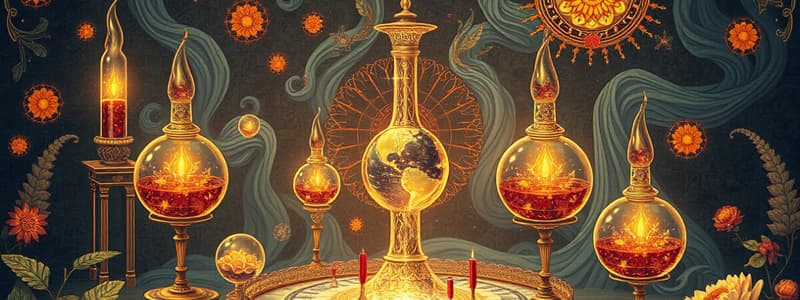Podcast
Questions and Answers
Arrange the following compounds in order of increasing boiling point temperature: HCl, H2O, SiH4.
Arrange the following compounds in order of increasing boiling point temperature: HCl, H2O, SiH4.
- H2O < SiH4 < HCl
- SiH4 < HCl < H2O (correct)
- H2O < HCl < SiH4
- HCl < SiH4 < H2O
Arrange the following compounds in order of increasing boiling point temperature: F2, Cl2, Br2.
Arrange the following compounds in order of increasing boiling point temperature: F2, Cl2, Br2.
- F2 < Cl2 < Br2 (correct)
- Br2 < F2 < Cl2
- Br2 < Cl2 < F2
- Cl2 < F2 < Br2
Arrange the following compounds in order of increasing boiling point temperature: CH4, C2H6, C3H8.
Arrange the following compounds in order of increasing boiling point temperature: CH4, C2H6, C3H8.
- CH4 < C2H6 < C3H8 (correct)
- C3H8 < C2H6 < CH4
- C2H6 < CH4 < C3H8
- C2H6 < C3H8 < CH4
Arrange the following compounds in order of increasing boiling point temperature: O2, NO, N2.
Arrange the following compounds in order of increasing boiling point temperature: O2, NO, N2.
The melting point of H2O(s) is 0 °C. The melting point of H2S(s) is -85 °C, and this is due to water having hydrogen bonds.
The melting point of H2O(s) is 0 °C. The melting point of H2S(s) is -85 °C, and this is due to water having hydrogen bonds.
Identify the intermolecular forces present in CH3CH2CH3.
Identify the intermolecular forces present in CH3CH2CH3.
Identify the intermolecular forces present in CH3CH2Cl.
Identify the intermolecular forces present in CH3CH2Cl.
Identify the intermolecular forces present in CH3CH2OH.
Identify the intermolecular forces present in CH3CH2OH.
The melting point of a substance increases as the strength of its intermolecular forces increases.
The melting point of a substance increases as the strength of its intermolecular forces increases.
The enthalpy of vaporization of CO2(l) is 9.8 kJ/mol, and that of CS2(l) is 28 kJ/mol. This is due to the higher molecular weight of CS2 which decreases the amount of intermolecular forces.
The enthalpy of vaporization of CO2(l) is 9.8 kJ/mol, and that of CS2(l) is 28 kJ/mol. This is due to the higher molecular weight of CS2 which decreases the amount of intermolecular forces.
The compounds are listed correctly in order of increasing boiling points: N2 < CS2 < H2O < KCl.
The compounds are listed correctly in order of increasing boiling points: N2 < CS2 < H2O < KCl.
The compounds are listed correctly in order of increasing boiling points: H2O < N2 < CS2 < KCl.
The compounds are listed correctly in order of increasing boiling points: H2O < N2 < CS2 < KCl.
How much heat is required to convert 422 g of liquid H2O at 23.5 °C into steam at 150 °C?
How much heat is required to convert 422 g of liquid H2O at 23.5 °C into steam at 150 °C?
From the phase diagram for water, determine the state of water at 35 °C and 85 kPa.
From the phase diagram for water, determine the state of water at 35 °C and 85 kPa.
From the phase diagram for water, determine the state of water at 40 °C and 0.1 kPa.
From the phase diagram for water, determine the state of water at 40 °C and 0.1 kPa.
From the phase diagram for water, determine the state of water at 75 °C and 3 kPa.
From the phase diagram for water, determine the state of water at 75 °C and 3 kPa.
From the phase diagram for water, determine the state of water at 15 °C and 0.1 kPa.
From the phase diagram for water, determine the state of water at 15 °C and 0.1 kPa.
From the phase diagram for water, determine the state of water at 60 °C and 50 kPa.
From the phase diagram for water, determine the state of water at 60 °C and 50 kPa.
From the phase diagram for water, determine the state of water at -15 °C and 0.5 kPa.
From the phase diagram for water, determine the state of water at -15 °C and 0.5 kPa.
At very low temperatures, oxygen, O2, freezes and forms an amorphous solid.
At very low temperatures, oxygen, O2, freezes and forms an amorphous solid.
As it cools, olive oil slowly solidifies and forms an amorphous solid over a range of temperatures.
As it cools, olive oil slowly solidifies and forms an amorphous solid over a range of temperatures.
Identify the type of crystalline solid formed by CaCl2.
Identify the type of crystalline solid formed by CaCl2.
Identify the type of crystalline solid formed by SiC.
Identify the type of crystalline solid formed by SiC.
Identify the type of crystalline solid formed by N2.
Identify the type of crystalline solid formed by N2.
Identify the type of crystalline solid formed by Fe.
Identify the type of crystalline solid formed by Fe.
Identify the type of crystalline solid formed by graphite (C).
Identify the type of crystalline solid formed by graphite (C).
Identify the type of crystalline solid formed by CH3CH2CH2CH3.
Identify the type of crystalline solid formed by CH3CH2CH2CH3.
Identify the type of crystalline solid formed by HCl.
Identify the type of crystalline solid formed by HCl.
Identify the type of crystalline solid formed by NH4NO3.
Identify the type of crystalline solid formed by NH4NO3.
Identify the type of crystalline solid formed by K3PO4.
Identify the type of crystalline solid formed by K3PO4.
Flashcards are hidden until you start studying
Study Notes
Boiling Points of Compounds
- Compounds arranged by increasing boiling point: SiH4 < HCl < H2O
- Series for halogens in increasing boiling points: F2 < Cl2 < Br2
- Alkanes in order of increasing boiling point: CH4 < C2H6 < C3H8
- For small nitrogen and oxygen molecules: N2 < O2 < NO
Melting Points and Intermolecular Forces
- Melting point of H2O(s) is 0 °C; H2S(s) melts at -85 °C due to stronger hydrogen bonds in water.
- Intermolecular forces in CH3CH2CH3 detected are dispersion forces.
- CH3CH2Cl exhibits dipole-dipole attractions and dispersion forces.
- CH3CH2OH shows hydrogen bonding along with dispersion forces.
- Increased melting point correlates with stronger intermolecular forces.
Enthalpy of Vaporization
- Enthalpy of vaporization: CO2(l) = 9.8 kJ/mol; CS2(l) = 28 kJ/mol.
- Higher molecular weight of CS2 does not decrease intermolecular forces; claim is false.
- Correct order of boiling points: N2 < CS2 < H2O < KCl, verified as true.
- Incorrect order of boiling points: H2O < N2 < CS2 < KCl, verified as false.
Heat Calculation
- To convert 422 g of liquid H2O at 23.5 °C into steam at 150 °C requires 1130 kJ of heat.
States of Water from Phase Diagram
- Water state at 35 °C and 85 kPa: Liquid.
- Water state at 40 °C and 0.1 kPa: Gas.
- Water state at 75 °C and 3 kPa: Gas.
- Water state at 15 °C and 0.1 kPa: Gas.
- Water state at 60 °C and 50 kPa: Liquid.
- Water state at -15 °C and 0.5 kPa: Solid.
Amorphous Solids and Crystalline Structures
- At very low temperatures, O2 does not form an amorphous solid; claim is false.
- Olive oil forms an amorphous solid upon cooling over a range of temperatures; true.
- Type of crystalline solid for CaCl2: Network covalent.
- SiC also classified as a network covalent solid.
- N2 identified as a molecular solid.
- Fe is categorized as a metallic solid.
- Graphite (C) is classified as a network covalent solid.
- CH3CH2CH2CH3 and HCl classified as molecular solids.
- NH4NO3 and K3PO4 identified as ionic solids.
Studying That Suits You
Use AI to generate personalized quizzes and flashcards to suit your learning preferences.



